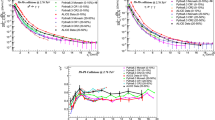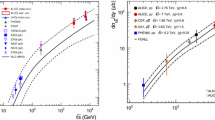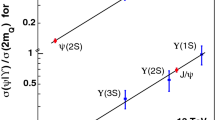Abstract
Validity and consequences of the quark line rule (QLR) in nucleon (N)— antinucleon (¯N) annihilations into two or three mesons at LEAR energies are investigated. Recent data on proton-antiproton annihilation into anη orη′ together with additional non-strange pseudoscalar or vector meson (s) is used to successfully test the rule. We find that for present data any pseudoscalar meson mixing angle ΦPS restricted to −260<ΦPS<−2.20 is approximately consistent with the QLR. Since the assumptions leading to this test are valid in any present-day quark model of nucleon-antinucleon annihilation, improvement of the data will be of utmost importance. If proven valid, the QLR can be used to test if quark-antiquark annihilation dominates over quark exchange inN¯N → mesons at LEAR energies or vice versa. Previously proposed tests of the quark line diagrams (annihilation or rearrangement) describing the quark flavor flux under either of these assumptions are worked out. We investigate without a definite conclusion if dominance of annihilation over rearrangement is consistent with present data onp¯p → π0 π0,ηη, π0ρ0, π0ω, ηρ0,ηω, ρ0ρ0,ωω. As a main consequence, dominance of annihilation predicts without any ambiguity equality of the proton-antiproton annihilation cross sections σ(ωω) and σ(ρ0ρ0). Further consequences of dominance of either annihilation or rearrangement diagrams for proton-antiproton annihilation into two or three mesons are also worked out. We compare the predictions of the models we discuss to the sparse present data. It is emphasized that our predictions only exploit the quark flavor flux within the quark line diagrams that are assumed to dominate. They thus are independent of gluon contributions to these diagrams.
Similar content being viewed by others
References
Blüm, P., Büche, G., Koch, H.: Antiproton proton annihilation at rest — a data compilation. Internal Report. Kernforschungszentrum Karlsruhe, November 1988
Genz, H.: Phys. Rev. D28, 1094 (1983)
Genz, H.: Phys. Rev. D31, 1136 (1985)
In Refs. 2 and 3, statistical factors have been omitted. See Ref. 5 and the present paper for corrections
Genz, H.: AIP conference proceedings 176, Intersections between particle and nuclear physics. Rockport, ME 1988, Bunce, G.M. (ed.), p. 405
Malvetti, M.: SU(3). — Analyse von Baryon-Antibaryon Reaktionen. Diplomarbeit, Karlsruhe (1985)
Hartmann, U., Klempt, E., Körner, G.: Phys. Lett.155B, 163 (1985)
Hartmann, U., Klempt, E., Körner, G.: Z. Phys. A — Atomic Nuclei331, 217 (1988);
Klempt, E.: Z. Phys. A — Atomic Nuclei331, 211 (1988)
Malvetti, M.: Private communication
Klempt, E.: Private communication
Le Yaouanc, A., Oliver, L., Pene, O., Raynal, J.-C.: Hadron transitions in the quark model. London, New York: Gordon and Breach 1988
Okubo, S., Jagannathan, S.: Phys. Rev. D16, 177 (1977)
Ellis, J., Gabathuler, E., Karliner, M.: CERN-Preprint-TH-5180/88
Particle Data Group: Phys. Lett. B204, 1 (1988)
Gilman, F.J., Kaufman, R.: Phys. Rev. D36, 2761 (1967)
Diaz, J., et al.: Nucl. Phys. B16, 239 (1970)
Baltay, C., et al.: Phys. Rev.145, 1103 (1966)
Bloch, M., et al.: Nucl. Phys. B23, 221 (1970)
Bizarri, P., et al.: Nucl. Phys. B14, 169 (1969)
Baltay, C., et al.: Phys. Rev.140, B 1042 (1965)
Soulliere, M.: Ph. D. Thesis, Pennsylvania State University (1987)
Adiels, L., et al.: Z. Phys. C — Particles and Fields42, 49–58 (1989)
Barash, N., et al.: Phys. Rev.145, 1095 (1966)
Rubinstein, H.R., Stern, H.: Phys. Lett.2A, 447 (1966)
Maruyama, M., Ueda, T.: Nucl. Phys. A364, 297 (1981)
Author information
Authors and Affiliations
Additional information
Two of the authors (M.M. and S.T.) would like to thank their collegues at the Institut für Theoretische Kernphysik der Universität Karlsruhe for the hospitality they have received. This work has been supported by the Bundesministerium für Forschung und Technologie under grant number MEP 02-34KAG.
Rights and permissions
About this article
Cite this article
Genz, H., Martinis, M. & Tatur, S. Something, but not much follows from the quark line rule in nucleon-antinucleon annihilations. Z. Physik A - Atomic Nuclei 335, 87–94 (1990). https://doi.org/10.1007/BF01289351
Received:
Revised:
Issue Date:
DOI: https://doi.org/10.1007/BF01289351




